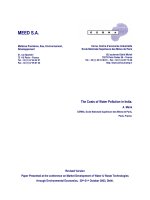A cubic micron of water contains about 90 billion atoms
Bạn đang xem bản rút gọn của tài liệu. Xem và tải ngay bản đầy đủ của tài liệu tại đây (664.13 KB, 46 trang )
Chapter 19 & 20
Esters, Amides and Carbohydrates
Chemistry B11
EstersFormation of Esters
RC O H
O
A carboxylic acid
=
Fischer Esterification
RCO R
'
O
RC-OH
O
H
-
O R
'
=
=
An alcohol
A carboxylic acid
An ester
H
2
SO
4
+ H
2
O
•
Name the alkyl group from the alcohol –OR.
•
Followed by name of the acid in which the suffix “-ic acid”
is replaced by suffix “-ate”.
acid alcohol
|| methyl
CH
3
—
C—O —CH
3
ethanoate IUPAC: methyl ethanoate
(acetate) common: methyl acetate
Naming of Esters
O
propyl
CH
3
—
C—O —CH
2
—CH
2
—CH
3
Propyl ethanoate (IUPAC)
Propyl acetate (common)
CH
3
—CH
2
—C—O—CH
2
—CH
3
Ethyl propanoate
Naming of Esters
O
O
CH
3
—
C—OH + HO—CH
2
—CH
3
CH
3
—
C—O—CH
2
—CH
3
+
H
2
O
Fischer Esterification
H
2
SO
4
Ethanoic acid
(Acetic acid)
Ethanol
(Ethyl alcohol)
Ethyl ethanoate
(Ethyl acetate)
O
Esters give flowers and fruits their pleasant fragrances and
flavors.
Properties of Esters
Hydrolysis: reaction with water.
(breaking a bond and adding the elements of water)
RCO R '
O
RC-OH
O
H
-
O R
'
=
=
An alcohol
A carboxylic acid
An ester
+ H
2
O
+
Heat
Acid
Properties of Esters
Saponification (Hydrolysis): an ester reacts with a hot aqueous base.
RCO R
'
O
RCO-Na
O
H
- O R
'
=
=
An alcohol
A sodium salt
An ester
+ NaOH
+
H
2
O
Heat
-
+
CH
3
CO
CH
2
CH
3
O
CO-Na
O
CH
3
CH
2
OH
=
=
Ethanol
Sodium acetate
Ethyl Ethanoate
+ NaOH
+
-
+
CH
3
Amides
In an amide, the -OH group in the carboxyl group of a
carboxylic acid is replaced by an Amino group (-NH
2
).
CH
3
—
C—OH CH
3
—
C — NH
2
Amides
=
O
=
O
Formation of Amides
RC O H
O
A carboxylic acid
=
RCNHR
'
O
RC-OH
O
H
-
N HR
=
=
An Amine
A carboxylic acid
An amide
Heat
+ H
2
O
'
H
2
OCH
3
C-NHCH
2
CH
3
O
H HN CH
2
CH
3
CH
3
C-OH
O
+
+
Acetic acid
Ethanamine
N-ethylethanamide
Change the end of the name of the carboxylic acids from
“-oic acid” to “-amide”.
methanoic acid
H–C–NH
2
methanamide (IUPAC)
propanoic acid
CH
3
–CH
2
–C–NH
2
propanamide (IUPAC)
Naming of Amides
O
=
=
O
CH
3
–C–NH–CH
3
N-methylethanamide
CH
3
–CH
2
–C–N(CH
3
)
2
N,N-dimethylpropanamide
CH
3
–C–N(CH
2
CH
3
)
2
N,N-diethylethanamide
Naming of Amides
=
O
=
O
=
O
Properties of Amides
Such as esters:
Hydrolysis in hot aqueous acid or base
Carbohydrates
6CO
2
+ 6H
2
O + energy C
6
H
12
O
6
+ 6O
2
Photosynthesis
Respiration
•
Produced by photosynthesis
in plants.
•
The major source of energy
from our diet.
•
Composed of the elements
C, H, and O.
glucose
C
n
(H
2
O)
n
Carbohydrates
-
The most abundant organic compounds in the plant world.
-
3/4 of the weight of plants.
-
1% of the weight of animals and humans (they do not store).
-
65% of the foods in our diet.
Carbohydrates
1. Monosaccharide + H
2
O no hydrolysis
H
+
or enzyme
2. Disaccharide + H
2
O two monosaccharide units
+
3. Polysaccharide + many H
2
O many monosaccharide units
H
+
or enzyme
H
+
or enzyme
Monosaccharides
Monosaccharides are carbohydrates with:
•
3-9 carbon atoms
•
A carbonyl group (aldehyde or ketone)
•
Several hydroxyl groups
C
n
H
2n
O
n
A carbohydrate that cannot be split or hydrolyzed into smaller carbohydrates.
║
C ─ H
│
H─ C ─ OH
│
H─ C ─ OH
│
CH
2
OH
O
C
n
(H
2
O)
n
Aldose is monosaccharide:
•
With an aldehyde group and many
hydroxyl (-OH) groups.
•
triose (3C atoms)
•
tetrose (4C atoms)
•
pentose (5 C atoms)
•
hexose (6 C atoms)
“Aldo-” + suffix
O
║
C ─ H aldose
│
H─ C ─ OH
│
H─ C ─ OH
│
CH
2
OH
an aldotetrose
(Erythose)
Monosaccharides - Aldose
Monosaccharides - Ketose
Ketose is monosaccharide:
•
With a ketone group and many
hydroxyl (-OH) groups.
•
triose (3C atoms)
•
tetrose (4C atoms)
•
pentose (5 C atoms)
•
hexose (6 C atoms)
“Keto-” + suffix
CH
2
OH
│
C = O ketose
│
H─ C ─ OH
│
H─ C ─ OH
│
H─ C ─ OH
│
CH
2
OH
a ketohexose
(Fructose)
Some important Monosaccharides
Glucose
(C
6
H
12
O
6
, aldohexose) – blood sugar
•
Is found in fruits, vegetables,
corn syrup, and honey.
•
Is found in disaccharides such as
sucrose, lactose, and maltose.
•
Makes up polysaccharides such
as starch, cellulose, and glycogen.
HHO
H
CH
2
OH
OHC
H
H
OH
OH
C
C
C
OH
C
Some important Monosaccharides
Fructose
(C
6
H
12
O
6
, ketohexose),
•
Is the sweetest of the carbohydrates.
•
Is found in fruit juices and honey (fruit sugar).
•
In bloodstream, it is converted to its isomer,
glucose.
•
Is bonded to glucose in sucrose (a
disaccharide known as table sugar).
O
HHO
H
CH
2
OH
OHC
H OHC
C
C
CH
2
OH
Some important Monosaccharides
Galactose
(C
6
H
12
O
6
, aldohexose),
•
Has a similar structure to glucose
except for the –OH on Carbon 4.
•
Cannot find in the free form in nature.
•
Exist in the cellular membranes of the
brain and nervous system.
•
Combines with glucose in lactose (a
disaccharide and a sugar in milk).
HHO
HHO
H
CH
2
OH
OHC
H OH
C
C
C
OH
C
Galactosemia
missing the enzyme that convert galactose to glucose.
Accumulation of galactose in the blood and tissues.
Disease - Galactosemia
Mental retardation and cataract
Solution: removing the galactose from food: no milk.









